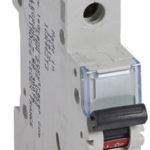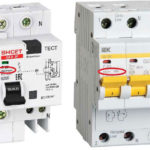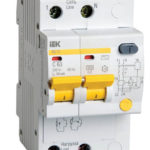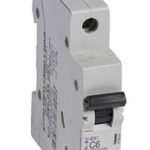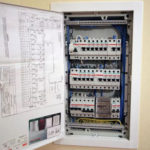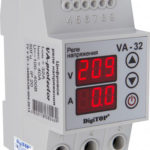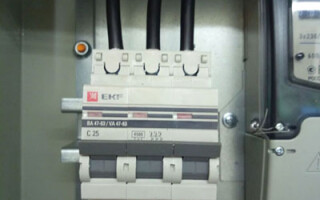When installing an electrical network in a private house or apartment, it is important to choose the right circuit breakers for each line based on the power of the connected electrical appliances. All of these protective devices are usually installed in the electrical panel and provide protection against overload or short circuit. But if all these devices protect the lines to the consumer of electricity, then a device is needed that will protect the group of machines in the shield. Such a device is the so-called "introductory" machine.
Content
The purpose of the introductory machine
In order to understand why we still need an “introductory “machine”, we will briefly understand what a circuit breaker is in the general case and why it is needed.
Automatic safety switch - a contact switching device that is able to turn off electrical networks in the event of an emergency situation (overload or short circuit).
The introductory machine in appearance, mechanism of operation and design is no different from a conventional protective device that controls any electrical line. The only and most important difference is its denomination, which for a certain (calculated) order higher, taking into account selectivitythan any line safety switch in the electrical panel.
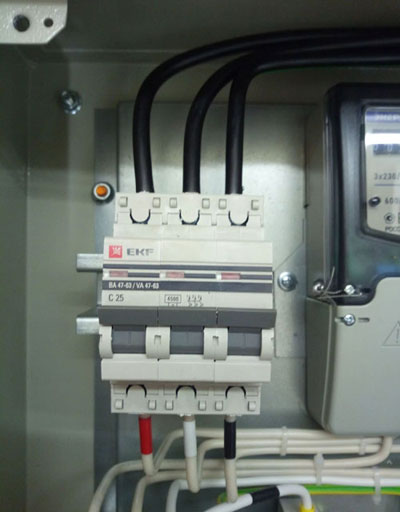
An introductory machine must be installed when an electrical cable is entered into an apartment or a private house. It protects in general the entire electrical network of the residential premises from overload, and also serves to turn off the power to the entire facility (e.g. for electrical and other repairs). It also ensures the correct operation of the supply cable and does not allow exceeding the load set for this room.
Main selection criteria
In order to choose the right introductory machine (VA), you need to know what characteristics you should pay attention to when buying.
Rated current
This is the most important characteristic when choosing an incoming protective device. This property of the device indicates the maximum current, above which the power will turn off, for a certain time.
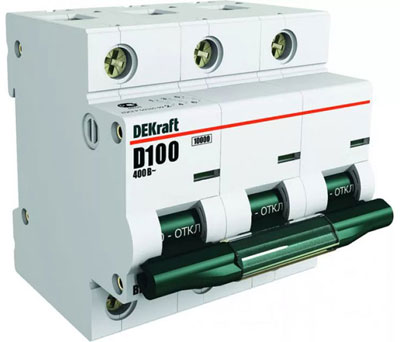
Note! Circuit breakers are used to protect the cable from overheating and denomination must be selected taking into account the cross-sectional area of the conductors!
Regardless of whether the machine is introductory or provides protection for a specific line (wires), it is calculated according to the maximum power of electricity consumers. The rating of the input device is chosen by calculating the power (or current) of all consumers while being connected to the network, for greater security, reduce the resulting number by 10-15%, rounding down.
Number of poles
There are machines with a different number of poles. Single-pole is used to protect individual lines. The functions of the introductory machine are usually performed by two, three or four-pole circuit breakers.
An important rule that will help you choose the number of poles is that for single-phase networks, two-pole machines are used, and for three-phase networks, three or four-pole.
Two-pole circuit breakers are made with a lever common to both poles and a trip mechanism. That is, in an emergency, two poles are disconnected at once (usually a phase is connected to one terminal, zero to the second). Such devices are often used in single-phase networks of residential premises of apartment buildings.
Three-pole (or four-pole) the machine is used when entering an electric cable into private houses with a three-phase network, as well as in industrial buildings and even in some apartments. Each terminal of the device is connected in phase (and zero if it is a quadripole). It also, like a two-terminal device, has one common lever for all poles and, in case of overload, cuts off power to all phases.
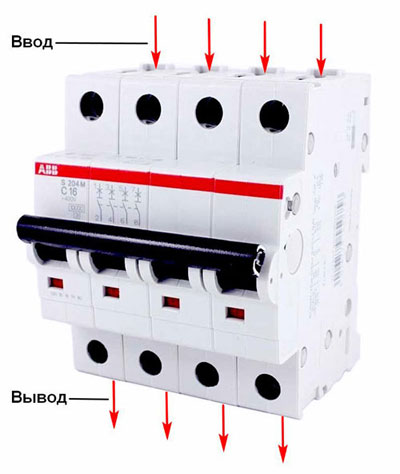
Time-current characteristic
It characterizes the instantaneous trip current and is most often indicated on the device in Latin letters B, C or D.The sensitivity of the protective device to the inrush currents of electrical appliances and equipment depends on the time-current characteristic. For an introductory circuit breaker, this property is important, since it affects the operation of lower groups of automata.
Most often, the following types of automata are used according to the time-current characteristic:
- B - at a current value 3 - 5 times higher than the nominal value, the electromagnetic switch of the device will work and it will instantly turn off;
- C - the electromagnetic release will turn off the device when the current is exceeded by 5-10 times;
- D - will work when the current is exceeded by 10-20 times from the nominal.
For an introductory machine to residential premises, devices with a time-current characteristic of type C are used, since most household appliances do not have large starting currents and will not adversely affect the electrical network of an apartment or house.
The operation characteristics of each device are indicated in the passport and instructions of the manufacturer of the circuit breaker.
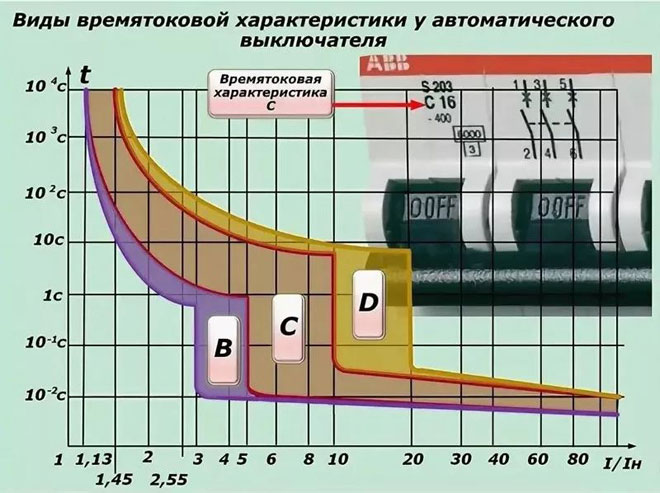
Mounting method
All circuit breakers have a standard mount and are placed on a DIN rail in the electrical panel. The same rule applies to introductory machines. The exception is special devices for industrial purposes, which can be fixed without a din rail to special mounts.
Switch brand
When choosing an introductory protective switch, as well as in the case of choosing any electrical devices, it is important to focus on a well-known manufacturer that has earned recognition. Such manufacturers give a quality guarantee for their devices and produce reliable, durable and safe circuit breakers.The most popular at the moment include machines from the following manufacturers:
- ABB is a Swedish-Swiss brand that produces high-quality electrical products. The circuit breakers of this company are compact, high-quality assembled devices that provide reliable protection of the electrical network from emergencies.
- Schneider Electric is a French company whose products are widely represented in Russia. The circuit breakers of this company are affordable, reliable and durable, they instantly work when the rated current is exceeded.
- Legrand - is also a French company with a worldwide reputation. It often appears in the ratings of electrical products and deservedly is one of the best manufacturers of circuit breakers in Europe.
- IEK - a Russian company whose circuit breakers compare favorably in price and are devices of acceptable quality. The machines of this company from domestic devices are the most popular due to their availability and are used in many apartments and private houses.
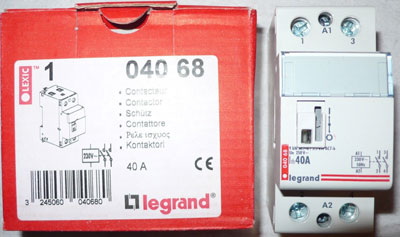
Calculation of the rating of the introductory circuit breaker
The performance of devices and the safety of the electrical network in a residential building or apartment directly depends on the correct choice of circuit breakers, including the input device. To calculate the value of the introductory machine, you need to have some electrical knowledge.
For a private house 380 V 15 kW
To calculate the introductory machine for a private house, it is necessary to take into account the following values: mains voltage (U), power (P) of all electrical appliances that will operate on the network, a correction factor that takes into account the simultaneous inclusion of electrical appliances and the quality of the electrical wiring.
Calculation example:
Suppose that the sum of the capacities of all electrical appliances in a residential building is 15 kW (the same capacity in Russia is usually supplied to private residential buildings) at a voltage of 380 V. To calculate the current, we use Ohm's Law for an electrical circuit:
I=P/U;
I=15000/380 = 39.47 A.
Enter a correction factor. Since all electrical appliances in the house will not turn on at the same time and, given the old electrical wiring, we take the value of the correction factor equal to 0,85.
In \u003d 39.47x0.85 \u003d 33.55.
The closest nominal values of machines: 32 A and 40A. We choose the denomination to the smallest side. And we get that for our private house an introductory three-pole or four-pole machine is needed for 32 A.
For an apartment 220 V
For apartments with a voltage of 220 V, the calculation of the introductory machine is similar to the choice of a machine for a private house. The only difference is that the power and voltage of the network will change.
Calculation example:
Let's assume that the sum of the powers will be equal to 10 kW, we will take the correction factor 0.85, and the voltage, as we already know, is 220 V. Then:
In \u003d 10000 / 220 * 0.85 \u003d 45.45x0.85 \u003d 38.63.
Based on the value obtained and rounding the rating to the smallest, we select the circuit breaker 32 A.
Connection diagram of the introductory machine
Fundamentally, the installation and connection of the introductory machine is practically no different from installing a conventional circuit breaker. This machine is mounted on din-rail and connects to the counter (with obligatory sealing) or after. Further, the rest of the machines are already mounted from it to protect each line of the residential premises.
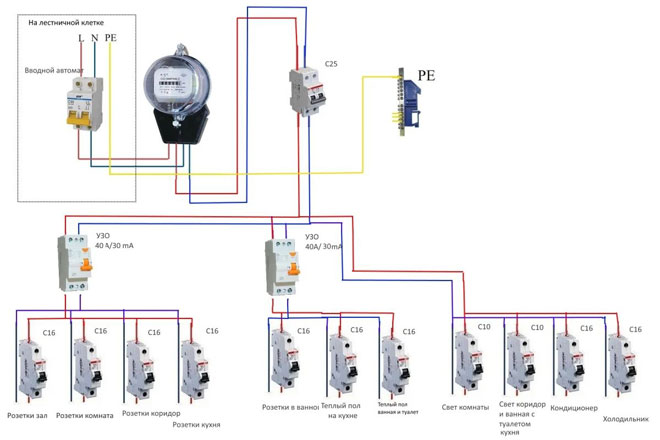
Unacceptable purchase errors
The most common mistakes when choosing and buying an introductory circuit breaker are ignorance of the principles of its operation and choosing the value of the machine below or above the required value. If you choose an automatic machine with a lower rating, then a false operation of the protection and shutdown of the entire apartment due to one device is possible. If you select a rating higher than the required value, it may work after the insulation of the wires, or the devices inside the electrical panel overheat and begin to melt or burn.
There are also "professionals" who connect two single-pole circuit breakers instead of a two-terminal network, not knowing that this violates electrical safety requirements and the PUE prohibits such a connection.
If you have any doubts about the choice and installation of such a device, you should contact a professional electrician and be calm for the right choice and safe installation.
Similar articles:
